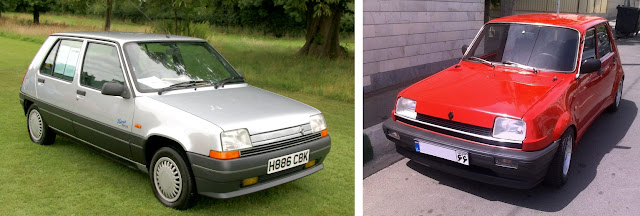Introduced January 1972
The history of postwar European car design has several chapters. Immediately after the Second World War, motor manufacturers simply started with the designs they had in the 1930s and went from there. Although this had some successes such as the 2CV, the average motorist in the early 1950s had a choice of expensive and not terribly up-to-date vehicles to choose from.
By the late 1950s, smaller cars such as the Fiat 500 came to the market. Much cheaper than anything else about, they were still practical and useful and a great deal of what followed was inspired by the idea of cheap motoring. Renault in particular had found success with the 1961 Renault 4 which despite being rather basic and slow was popular for its interior space and its versatile cargo bay.
By the end of the decade technology and design had moved on. The bulk of demand was still for small cars, and it was becoming obvious that the idea of a hatchback offered maximum versatility, especially in a small car. Simca had strong sales for the compact 1100 during this period, but it was rather stuck in the 60s in terms of design. The market was ripe for a change.
Into this story came a designer named Michel Boué who worked for Renault. As a side project he had been working on a design for a compact and modern hatchback. Although it was never an official project, it eventually came to the attention of Renault’s management who were impressed and commissioned a prototype, with the car being green-lit for production as the Renault 5, with a formal launch in January 1972.
 |
| Renault 5 |
A front-engined, front-wheel drive car with bang-up-to-date styling, the 5 looked far more modern than rivals which were stuck in the sixties. The Renault 5 firmly looked forward to the 1970s. Styling features included rectangular headlights, large (and effective) plastic bumpers and a large hatch at the back with narrow lights on either side to maximise loading capacity.
 |
| The Renault 5 certainly had bags of style.. |
Over its lifetime the selection of engines ranged from a tiny 0.8 litre unit of a 1950s vintage to a rather spicy 1.4 litre turbo. Weighing only around 800kg, the Renault 5 didn’t need a whole lot of power to propel it. It loaned itself to hot hatches (such as the Alpine and Gordini variants) and even a mid-engined sports car with the epic Renault 5 Turbo. There were a few odd things about it, such as the wheelbase being different on either side of the car, but overall this was a very capable package.
Crucially, the 5 was ahead of most of the competition in terms of launch date. Even the contemporary Fiat 127 wasn’t available as a hatch at launch (it was a saloon), and rivals Volkswagen, GM Europe and Ford were years behind. Even the original hot hatch versions pipped the classic Golf GTI to the post by two months.
 |
| Renault 5 Turbo and US-Spec Le Car |
Unusually for a small French car it was also sold in the United States by Renault’s partner AMC under the questionable name of the Renault Le Car. The 5 was sold widely around the world, and it was manufactured in diverse countries such as Venezuela, South Africa and Iran in addition to its home country of France.
A successful and iconic design, the 5 nonetheless has its share of tragedy. Michel Boué died of cancer before it came to market, robbing Renault of a potentially very talented designer – grimly echoing the death of Pio Manzù, who was the designer of the Fiat 127 and who also died before it came to market.
In 1984 a new version was launched. The completely new Supercinq updated the styling and technologies for the new decade. Whether you prefer the original or sequel is a matter of taste, but the Supercinq was also successful and stayed in production until 1996 when it was replaced with the first generation Renault Clio.
As for the original 5 – it had a strange afterlife in Iran as the Renault PK which was an odd mashup of Renault and Kia parts. Also a rather curious an electric version of the original 5 was sold in the US during the 1970s and 1980s called the “Lectric Leopard”. Renault themselves demonstrated an electric concept version of the 5 in 2021, although whether the Renault 5 badge will ever see production again is questionable.
 |
| Second-generation "Supercinq" and Iranian Renault PK |
As for significance – before the Renault 5 only a small few cars had hatchbacks, and afterwards pretty much all small cars followed suit with the extra door on the back. This basic configuration stayed popular well into the 21st century when it started to be replaced with larger and more unwieldy crossovers.
Today, unmolested hot hatch versions of any Renault 5 model can cost you £30,000 or much more with racing spec versions coming in at up to £100,000. More sedate versions of the original 5 are pretty hard to find these days, and even basic second-gen cars can go for a few thousand pounds. It seems the 5 still has it fans, even decades after launch.
Image credits:
Mic via Wikimedia Commons - CC BY 2.0
Mic via Wikimedia Commons - CC BY 2.0
Spanish Coches via Flickr - CC BY 2.0
Spanish Coches via Flickr - CC BY 2.0
Alexander Migl via Wikimedia Commons - CC BY-SA 4.0
Jonathan Kellenberg via Flickr - CC BY 2.0
Kamran Ba via Wikimedia Commons - CC BY-SA 4.0
Steve Knight via Flickr - CC BY 2.0

No comments:
Post a Comment